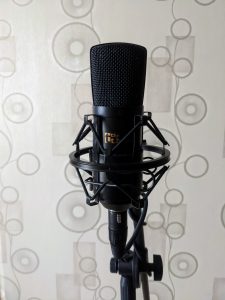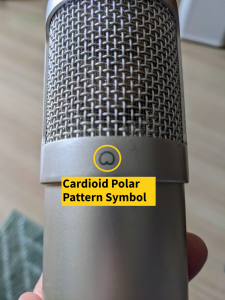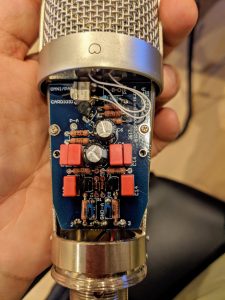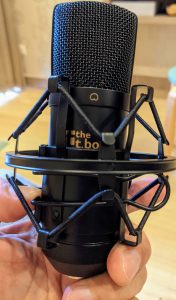Microphones
There are lots of different kinds of microphones; condenser, dynamic, ribbon, PZM, etc. We're going to focus on one particular type, as it's the best suited for a home studio that only has one or two mics.
Large Diaphragm Condenser Microphones
If you're only going to get one mic, it should probably be a large diaphragm condenser mic. They can pick up the subtleties of delicate instruments such as acoustic guitar, and they handle voice very well.
Probably 95% of the vocals you hear on professional recordings, were made on large diaphragm condenser mics. But if you have a dynamic, Shure SM57 sitting around, don't worry. The top selling record of all time featured this $100 mic on most of the vocals.
But a large diaphragm condenser covers pretty much all the bases (and the basses, too).
Phantom Power
Condenser mics need power. Some have internal batteries, but the most common power source is phantom power, supplied by your audio interface. Phantom power runs up the mic cable, to power your mic. If you are going to buy a condenser mic, make sure your interface has phantom power.
How Many Mics Should I Get?
If you're going to record in stereo, you'll need two mics. However, lead vocals are recorded in mono. One mic is enough for that. Some instruments, such as acoustic guitar, can be recorded in mono, or stereo. You can use a couple of mics to record a guitar cabinet, too -- even if it's going to end up mono.
But for many songwriters, or solo artists recording their songs, one mic will do.
If you want to record everything live, rather than one instrument at a time, you'll need more mics. A folk duo who both sing and play acoustic guitar might need a mic for each guitar and a mic for each vocal.
Me? I write songs, sing, and play guitar. But I like my songs to have a full band sound. I create bass, drums, keys and other instruments virtually. I record tracks one at a time. I'd say 98% of the time, I'm fine with one mic.
Polar Patterns
A polar pattern describes how well the mic picks up sound from different directions. Condenser mics may or may not have a selection of polar patterns from which to choose. The different polar patterns are usually available via a switch on the front of the mic.
Bass Roll-Off
Some mics have a bass roll-off switch. This decreases the low end in the mic, which reduces rumble or mic stand sounds, as well as vocal plosives (pops from rushes of air from consonants such as 'p', or 'b').
Pads
Some mics have the ability to turn down the internal electronics to compensate if a sound source is overloading the circuit. This is useful if you're going to try to mic a snare or Marshall, on 10 (or 11).
Reasons To Buy A Dynamic Mic, Instead Of A Condenser
How To Get A Decent Quality Condenser Mic On A Budget
The gold standard for vocal mics in the top studios is a Neuman U87. The problem is, they can cost several thousand dollars. Ouch!
The good news is that, in the last 20 years, mic manufacturing has really opened up, and now there are lots of budget choices out there, that sound pretty good. Not U87 good, but close!
Here are some ways to get a high quality sound, on a budget.
Build A Mic Kit
There are some cheap condenser mics out there, you can find on sale for $89, or even $69. You can buy one, gut the insides, and use the body along with new, premium quality components. There are several companies that will send you kits to assemble yourself. Or, you can buy a body from them, too -- or pay them to put one together for you.
I did this. I bought a cheap Chinese manufactured mic, gutted it, and had someone do the soldering for me. It worked out for a few years, when the mic had a problem and the company's support was less than helpful. That was Microphone-Parts, and I won't recommend them (although the mic sounded good).
I haven't used the other companies out there, so I can't give you feedback (pun intended), but you can find online reviews. Many of the mic models are designed to mimic the sound quality of famous, high-end mics.
YouTube Shootouts
On YouTube, there are tons of videos doing comparisons to highly sought-after mics. Some of the budget mics sound really close to the big guns. Go to YouTube and type in the model of a mic you think might be a good match for you and the word "shootout". For instance, "U87 shootout". You'll come up with a list of videos. Go through them, and be honest with yourself. Can you really hear the difference? If you can hear the difference, is it a difference you think detracts from the quality of the voice? Is the difference worth $3k?
Each mic you like, do a quick search, and see if it's within your budget.
Buy An SC400
In one shootout, I saw a Thomann t.bone SC400, which is about a $50 mic. Danged if it doesn't sound pretty good. I up and ordered one. They are made in Germany and it cost me about another $50 in shipping. That's what I'm using now.
The build quality is good and it looks decent, too. I've been using it since my mic build project crapped out.
A Final Word About Mic Choice
Voices and instruments have personalities, and quirks. So do microphones. It's difficult to know which mic is going to match well with your voice or instrument. If you kind find a demo online with someone who has a similar voice, that's to your advantage.
But frankly, unless you can try a mic out for several hours, in the environment in which you're going to record, it's going to be somewhat of a crap shoot. Don't sweat it. Make your best guess, and move on. Learning to record well is a lifelong project. This isn't the last microphone you'll ever buy 🙂




